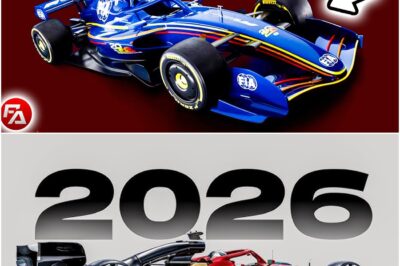In the high-stakes world of Formula 1, where every millisecond and every engineering innovation can mean the difference between victory and defeat, rivalries are the lifeblood of the sport. But the recent feud between McLaren and Red Bull transcended the typical on-track competition, evolving into a deeply personal and acrimonious battle, largely fueled by the animosity between McLaren CEO Zak Brown and former Red Bull team principal Christian Horner. This was a rivalry that went beyond the racetrack, playing out in the media and behind the scenes, with accusations of cheating and “F1 dark arts” that threatened to tarnish the sport.
The seeds of this bitter feud were sown long ago, but they blossomed into a full-blown war in the 2024 season. As McLaren’s performance surged, closing the gap to the dominant Red Bull team, the tension between the two camps became palpable. The rivalry was no longer just about which car was faster; it was a clash of personalities and philosophies, embodied by the two men at the helm.
Christian Horner, a titan of the F1 paddock, had built Red Bull into a powerhouse with a “them against us” mentality. He was a fierce defender of his team, known for his political maneuvering and willingness to engage in the “dark arts” of Formula 1 to gain an advantage. On the other side was Zak Brown, the charismatic American CEO of McLaren, who was not afraid to speak his mind and challenge the status quo. Brown had been a vocal critic of Red Bull’s ownership of two F1 teams and had not shied away from commenting on the personal controversies that had embroiled Horner.
The on-track battle escalated in May 2024, when McLaren introduced a significant upgrade package that transformed its car into a genuine contender for race wins. As McLaren’s star rose, Red Bull began to falter, struggling with the balance of its own car. It was then that the accusations began to fly. Red Bull, in a move that many saw as a desperate attempt to derail McLaren’s momentum, launched a series of provocative claims about the legality of the McLaren car.
The accusations were wide-ranging and, in McLaren’s view, increasingly outlandish. Red Bull alleged that McLaren was running illegally flexible front and rear wings, a classic F1 accusation that has been leveled against many successful teams over the years. They also claimed that McLaren was using a clever trick to cool its tires by adding water inside the wheel, a practice that would be difficult to police and could provide a significant performance advantage.

But the accusations didn’t stop there. Red Bull also suggested that McLaren was benefiting from “sneaky” changes to the construction of the tires and was using illegal methods to cool them, such as using special gases within the tires or heating and cooling their garages. These were serious allegations that, if proven true, could have resulted in severe penalties for McLaren.
McLaren, however, remained steadfast in its denials. Brown and his team were adamant that their car was entirely legal and that Red Bull’s accusations were nothing more than a smokescreen to distract from their own performance issues. The FIA, the sport’s governing body, conducted repeated and thorough inspections of the McLaren car, including a detailed post-race inspection in Miami. Each time, they found the car to be “totally legal,” vindicating McLaren and leaving Red Bull’s claims unsubstantiated.
For McLaren, Red Bull’s pursuit of these “wild theories” was more than just an annoyance; it was a distraction that they believed was ultimately harming Red Bull itself. They saw it as a waste of time and engineering resources that could have been better spent on improving their own car. Brown and his team were confident that they had done nothing wrong and that the truth would ultimately prevail.
The turning point in this bitter feud came in July, with the departure of Christian Horner from Red Bull. He was replaced by Laurent Mekies, a respected figure in the F1 paddock who had previously worked for Ferrari. With Horner’s departure, the personal animosity that had fueled the rivalry seemed to dissipate overnight.
In a move that would have been unthinkable just a few weeks earlier, Zak Brown and Laurent Mekies held a private meeting to “clear the air and start afresh.” It was a sign that a new era was dawning in the relationship between the two teams. Brown, for his part, expressed his belief that Red Bull under Mekies would not resort to the same tactics that had been employed under Horner’s leadership. He spoke of his hope for a “healthy competition” between the two teams, one that was fought on the track, not in the media.

Brown even went so far as to say that he envisioned Red Bull becoming more like modern-day Ferrari, a team that McLaren had a long and storied rivalry with, but one that was now a “friendlier adversary.” He felt that he could have private conversations with Mekies without the fear of them being used as “political weapons,” a clear dig at his previous relationship with Horner.
Mekies, while agreeing on the importance of healthy relationships between team leaders, also made it clear that Red Bull would not be a pushover. He stated that his team would not “hide our bias” and would continue to push the boundaries in their pursuit of victory. It was a clear message that while the personal animosity may be gone, the competitive fire still burned brightly at Red Bull.
The end of this bitter feud is a welcome development for Formula 1. While rivalries are essential to the sport, the one between McLaren and Red Bull had become toxic, with the personal attacks and unsubstantiated accusations threatening to overshadow the incredible on-track action. With a new sense of detente between the two teams, the focus can now return to what really matters: the thrilling battle for supremacy on the racetrack.
For Red Bull, the end of the Horner era presents an opportunity to refocus its efforts on what it does best: building world-beating F1 cars. And for McLaren, it is a chance to continue its resurgence without the distraction of off-track battles. The future of the McLaren-Red Bull rivalry remains to be seen, but one thing is for sure: the next chapter will be written on the track, not in the headlines.
News
The 2026 F1 Revolution: Faster, Slower, or Just More Dangerous?
Formula 1 is standing on the precipice of its most significant transformation since the dawn of the hybrid era in…
Revolution or Ruin? F1’s 2026 Rules Ignite a Firestorm of Driver Dissent and FIA Defiance!
The world of Formula 1 is a realm of constant evolution, a high-stakes chess match between engineering genius and raw…
The Battle for F1’s Soul: Why the Return of Turkey and Portugal is More Than Just a Race
Formula 1 is at a crossroads. As the sport continues its global expansion, a quiet but fierce battle is being…
Unbelievable: Lewis Hamilton’s shocking leak suggests Mercedes could obliterate every rival under the new F1 regulations, with claims of revolutionary tech, hidden testing, and a dominance so absurd that even Ferrari and Red Bull insiders are scrambling to find out if the nightmare is already inevitable.
F1’s 2026 Revolution: Rocket Speeds, Battery Clipping, and Why Mercedes Might Already Hold the Edge Formula 1 is no stranger…
The Empire Falls: Inside Red Bull’s Collapse and Verstappen’s Stark Warning for a Winless Future
In the high-octane world of Formula 1, dominance is a fragile and fleeting state. For years, the Red Bull Racing…
Explosive controversy erupts as Cadillac prepares its shocking Formula 1 debut in 2026, with critics mocking the speed, doubters predicting humiliation, and fans demanding urgent answers to burning questions: could this glamorous new team truly match legends or collapse in a storm of ridicule before the engines even roar?
Cadillac, Chaos, and Championship Clashes: What Awaits Formula 1 in the Second Half of 2025 A Reset After the Summer…
End of content
No more pages to load













